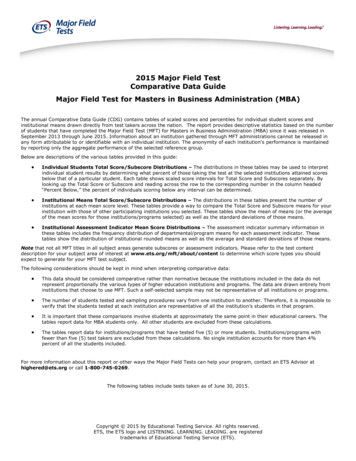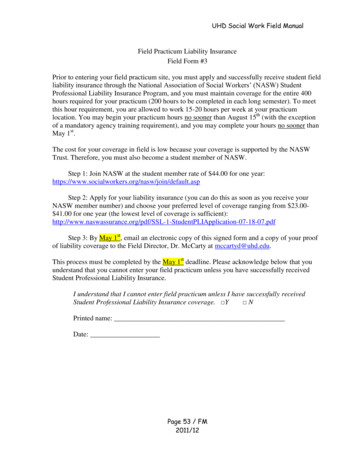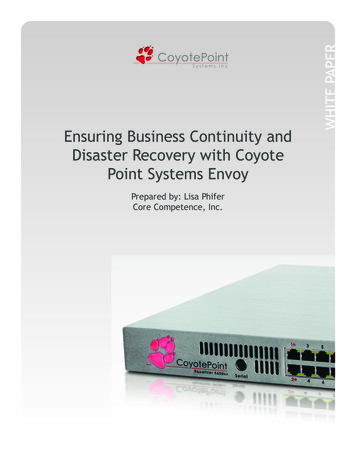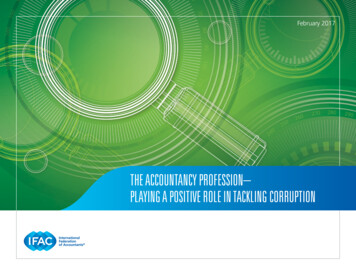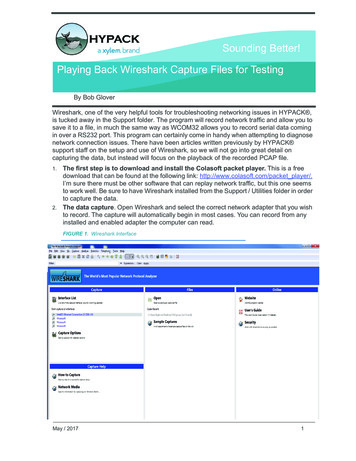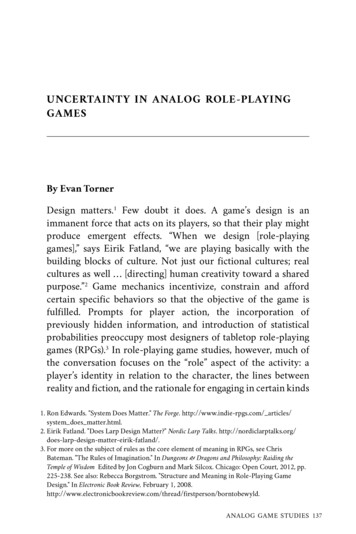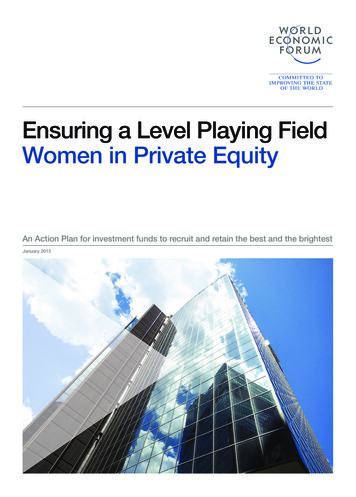
Transcription
Ensuring a Level Playing FieldWomen in Private EquityAn Action Plan for investment funds to recruit and retain the best and the brightestJanuary 2015
World Economic Forum2015 – All rights reserved.No part of this publication may be reproduced or transmitted in any form or by any means,including photocopying and recording, or by any information storage and retrieval system.BGender Diversity, Competitiveness and Private Equity
Gender Diversity, Competitiveness and Private EquityThe case for changeRecent research has observed a link between gender diversityin top management and superior financial performance. In 2013McKinsey & Company, the Credit Suisse Research Institute andCatalyst each published studies demonstrating a striking correlation between higher returns on sales, equity and invested capital,and gender diversity at the board of directors and executivemanagement level.1 As one example, companies with at leastone female board member outperformed comparable businesseswith all-male boards by 26 percent worldwide over a period ofsix years.2This issue extends beyond individual funds. In a recent survey of114 Limited Partners (LPs) three out of five respondents believedgreater gender diversity would benefit private equity firms.5, 6Many investors in private equity, such as pension plans and otherinstitutional investors, also note how this lack of diversity can beproblematic for their stakeholders and board members, particularly when a large portion of their beneficiaries are women (e.g.teacher or public service pension funds).Exhibit 2Proportion of women represented in:15%13%This Action Plan shares the learnings from the workshop, andis written for the leaders and human resource professionals ofprivate equity funds. We offer this not as a rigid prescription, butrather as a reference guide as each fund assesses the most effective path forward given their own unique culture and organization.18%On 9 October 2014, the World Economic Forum hosted a privateworkshop with 30 senior leaders in private equity funds, pensionplans and academia. The aim of the workshop was to explore theroot causes of the lack in gender diversity in private equity, and toexplore what can practically and realistically be done to addressthis imbalance. Over the course of the workshop, a better understanding of the underlying causes and best practices emerged.These studies focused on publicly listed companies. It is hard toimagine why they would not be relevant for private equity firmsand their portfolio companies, supporting the case for greatergender diversity. Yet there are currently fewer women at the entrylevels of private equity than there are represented in the mostpowerful leadership positions of Fortune 500 companies.3 Further,private equity funds have fewer women in senior roles than almostany other profession, and as of 2012 over 60% of US privateequity funds had no senior female professionals at all.417%Background10%5%5%0%Exhibit 1The Percentage of Females in Senior Roles Across ProfessionsBoard ofFortune 500companyExecutive Officerof Fortune 500companyPE (junior tomid levels)PE (seniorlevels)Source: Catalyst.org; Lietz, N.G., Harvard Business SchoolSource: 1. Alternative Investor; Chief Investment Officer, “The Missing Women of Asset Management”, June 20 2014; 2. Nori Gerardo Lietz, Harvard Business School;3. Real estate (4%) and private equity (6%); 4. Senior defined as women equity partners and general counsel of Fortune 500 corporations; 5. Listed Europeancompanies with more than 10,000 employees and/or revenue greater than 1 billion Euros. Source: Women Matter 2012, McKinsey. 9% equates to seats on theexecutive committee; 14% is senior management and vice president; 6. US Equal Opportunity Employment Commission; source from Catalyst Knowledge servicesGender Diversity, Competitiveness and Private Equity1
What is driving this gender gap?The gender gap in private equity starts with the number of women who are recruited for entry level positions, and then widens during careeradvancement. The key reasons underpinning the gender gap at each stage of the process are summarized below.APPLICATIONSThe sector may have developed image issues which deter women fromapplying in the first place. The limited number of women at senior andeven mid-levels can send a message to potential female applicants thatthey won’t have a ‘fair shot’ and their efforts are better directed elsewhere.RECRUITMENTBias in recruiting. Studies suggest subconscious biases against womenin technical roles could come into play when hiring.7Traditional recruiting pools for private equity come almost exclusivelyfrom investment banks, which also have low female representation.RETENTION / PROMOTIONWomen are less likely to attract the senior sponsorship needed to accelerate their careers. This can be due to halo effect – a tendency to advocatefor and mentor those similar to oneself.Women may be less likely to receive honest, concrete feedback both in realtime and in reviews. It has been observed that senior men can be uncomfortable delivering constructive criticism to younger women. Yet this feedback is critical for promotion/advancement and career path development.Studies have shown that women can face a ‘popularity’ penalty for beingtough, negotiating for themselves and deliberately networking – allimportant traits to advance in private equity.8Women are more likely to take on more child and home responsibilities,causing the ‘double work shift’.Women are more likely than men to take breaks from work if they havechildren. This can lead to an assumption of diminished professionalcommitment and no longer being ‘fully in the game’, casting womenoutside the informal networks needed for career opportunities.2Gender Diversity, Competitiveness and Private Equity
Prioritizing initiativesIn Exhibit 3 below, solutions and necessary conditions to tackle the gender gap are mapped out against ‘likely impact’ and ‘difficultyor cost to implement’. These points are expanded upon in the Action Plan below.Exhibit 3Gender Diversity, Competitiveness and Private Equity3
Action Plan – best practices to attract and retain top talentThe following checklist expands upon the key initiatives inExhibit 3, those which are found to have the highest impact.aClear commitment from leadershipto increase gender balanceLeadership trumps everything. A fund may enact all the actionsdetailed below, but if there is not a clear commitment by seniorleadership, the necessary cultural and behavioral changes will notbe enacted and the action plan will not succeed.Actively discuss and promote the business case for increasedgender balance, and how it is aligned with the values of fairness,respect and meritocracy. Develop and communicate a narrativethat highlights the importance of attracting the best talent.Acknowledge that firms are leaving talent on the table if they donot engage female professionals. Highlight stories of success.Many top business schools are increasingly focusedon improving gender diversity in the recruitmentprocess. As just one example, in January 2015,Harvard Business School (HBS), Stanford GraduateSchool of Business (Stanford), and The Wharton School(Wharton) compiled CV books of current high potentialbusiness school female students who have expresseda strong interest in private equity careers. The aim is toincrease the visibility of these students and to supportprivate equity firms who want to ensure high potentialfemale candidates are not being overlooked at the interview selection stage.For more information: Katherine.Bleich@weforum.orgAction:– Train senior leaders and provide them with coherent messaging before they ‘sponsor’ diverse talent; educate them onthe ‘current state’ of the firm, including specific numbers;generalities don’t work.aInterview Targets, Transparency& Tracking– Avoid presenting certain initiatives as gender specific. Forexample, more structured networking opportunities andrecruitment procedures are best practices independentof the benefits to diversity.Studies show that when equally qualified male and female candidates apply for a job, managers are still more likely to hire a man.9Most people have biases which impact objective recruitmentdecisions, and have a tendency to hire and interact with peoplewho are like themselves. This results in the proverbial ‘self-replicating organization’. 10– Stay clear of ‘well-meaning’ stereotypes when explaining thebenefits of gender parity, such as suggesting that women arebetter communicators or more collaborative than men.Interview targets can be an effective tool to increase the visibilityof female candidates, while avoiding the tokenism or internalbacklash potentially associated with hiring quotas.Make it explicit to recruiting firms that it is a policy to have adiverse pool of initial candidates for positions at all levels. Ameaningful portion (e.g. 30-50% at junior levels, 20-30% at seniorlevels) of first-round interview candidates should be women.Leadership by Example1. Be a sponsor. Encourage women to pursue theright opportunities that will further their careers.Get to know the talented women on your team, andask those women for feed back on what you can doto advance their career goals. Push for specifics.2. Encourage all voices to be heard in meetings.Actively solicit feedback from those who don’ttypically contribute.3. Challenge what you may perceive to beunconscious gender biases.This approach should of course be reinforced by methodicalinterview processes, where hiring criteria and qualifications aredecided upon pre-interviews, and candidates are marked asobjectively as possible against consistent criteria.Measurement and tracking of gender diversity are also powerful tools for change. In the recruitment process, track and reportdiversity by stage: CVs reviewed, interviews offered, offers given,end hires. In the promotion process, firms can track and reportgender diversity by seniority level. This may help managementidentify underlying issues and promote action. Given statisticallimitations, the value of tracking and measurement will be greaterfor larger funds.
It is crucial to give all employees detailed, specific feedback onhow to advance to the next level on a regular basis. Genderspecific biases in the nature and frequency of such feedbackneed to be avoided. Managers should be trained to ensure theyare able to provide real-time, concrete feedback to their staff.Offer discussion forums and training opportunities for leadersand managers on subconscious biases and how to managethem effectively.New thinking around maternity leaveaAn employer’s handling of maternity is a key retention factor forfemale staff. Handled well, fierce and long-term loyalty can bethe outcome. Handled badly, valuable talent is lost.Particularly in the early days, it is important to dispel the perception that maternity leave will be too hard or that burnout isinevitable. Both signal that private equity is not a desirable careerpath for women.Make sure there is a conversation and a future ramp up plan.Women who take maternity leave or even temporarily havereduced hours can find themselves ‘mommy tracked’, wherecolleagues (even subconsciously) doubt their commitment orambition, and don’t view them as potential future leaders. Theycan start to miss out on the critical, but more informal, informationflows. Well-meaning managers may guide less challenging projects their way, resulting in reduced responsibilities. These womenstart to feel demotivated, sidelined and may not see a path to‘catch up’ with peers, increasing the chances they will leave.To combat this, leaders of funds and women themselves mustensure proactive and constructive conversations at the pointof embarking on or returning from maternity leave. A clear planshould be formulated for getting back into challenging transactions and projects.“The highly ambitious women who electedinto private equity in the first place, arelikely to be seeking more challengingassignments, and more opportunitiesfor career growth post children.“a FeedbackaParticipant quote from 9 October 2014 Forum meetingon Gender Diversity & Private EquityVisibility of senior womenin recruitingEnsure senior women are visible in the interview and recruitment processes, demonstrating to potential hires that this is anenvironment where talented women can thrive and there areroadmaps to their success. Combat the notion that private equityis not friendly to women who wish to have children by providingexamples of successful female employees with creative andflexible work arrangements.Importantly, men must be prepared to speak about theimportance of diversity within the recruitment process withoutappearing scripted.aStructured internal firm networkingevents between senior leadershipand junior professionalsFor junior professionals, visibility and the potential to form closerelationships with senior management is critical for advancement.Men often have access to more informal networking opportunitiesand connections with the predominantly male leadership.Encourage men to also take paternity leave benefits, reinforcingthat taking time for parenthood is both acceptable and expectedfor both genders. Train professionals who are working directlywith or supervising parents-to-be on how to have conversationsabout maternity and paternity leave.Formal sponsorship programs – where young high potentials areconnected with sponsors who advocate for their protégés’ careeradvancement – are highly effective tools in larger organizations.However, they may not suit the smaller staff size of many privateequity funds. Structured networking opportunities for junior, andmid-level professionals to interact and connect with senior leadership might be more appropriate in this context. To succeed, theseefforts must have involvement and clear commitment from thesenior men within the firm.aaExpand the hiring
27.08.2014 · private equity funds have fewer women in senior roles than almost any other profession, and as of 2012 over 60% of US private equity funds had no senior female professionals at all.4 This issue extends beyond individual funds. In a recent survey of 114 Limited Partners (LPs) three out of five respondents believed greater gender diversity would benefit private equity firms.5, 6 Many investors .
